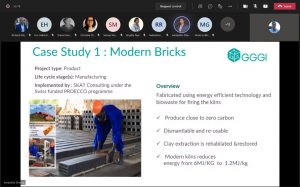19th October 2021, Kigali – The Global Green Growth Institute (GGGI) Rwanda held a virtual validation workshop for the research study on circularity in Built Environment (CBE) in Rwanda. GGGI has been appointed by the One Planet Network (OPN) to conduct an assessment on circularity in built environment in Africa. The study is part of a wider research in Asia, Africa, and Latin America, and supplements an earlier study State of Play for Circular Built Environment in Africa conducted in 2020. For this research, GGGI focused on four African countries – Burkina Faso, Rwanda, Senegal, and Uganda.
With the building and construction industry accounting for over 40% of final electricity consumption and a substantial proportion of global material consumption, it is essential to explore ways to reduce the energy and material throughput of the industry. This Assessment supports the global focus on mitigating GHG emissions by focusing on the building and construction sector, while simultaneously addressing other environmental concerns such as solid waste management and raw material extraction. Co-benefits, such as improved indoor air quality, reduced air pollution, job creation, etc. will also be highlighted in the study where relevant.
Since June 2021, several stakeholders have been engaged in the Rwanda CBE study including the academia, building materials manufacturers, water & waste companies, building designers, contractors & energy companies, regulators, and government agencies. The study involved interview discussions with stakeholders, site visit to projects that promote circularity and online survey where practitioners shared insights on measuring circularity in the building and construction industry.

Subsequently, GGGI hosted the virtual validation workshop that included several stakeholders from the built environment such as representatives of the government agencies Ministry of Infrastructure (MININFRA), Rwanda Housing Authority (RHA), City of Kigali (CoK) and private sector stakeholders including MASS Design, SKAT Rwanda, Earth Enable, Seyani Brothers, Landmark Studio and International Growth Center. The purpose of the validation was :
- to discuss and consolidate the data as well to validate the findings from Rwanda study so as to respond to the key objectives including highlighting good practices/projects/policies, etc. that promote circularity of energy, water and materials in the building industry;
- to gather industry practitioner perspectives on opportunities for greater circularity and ways to measure this;
- to ascertain the impacts of the built environment on the natural environment and the society;
- to discuss key challenges and ways to address them
During the validation workshop, GGGI Rwanda Country Representative stressed that circular environment preserves the value of resources to avoid the use of virgin materials and reduce waste. Consequently, it decreases the demand for resources and the emissions associated with the production and transportation of materials, as well as the construction process itself. He also mentioned circular practices in the built environment such as diverting construction and demolition waste from landfills, substituting cement and steel with more regenerative materials, and using renewable energy for heating and cooling, that can save 13.61Gt of materials and 11.82Gt of emissions globally. Ultimately, a circular economy will limit global temperature rise to less than 2°C instead of 3.4°C that is predicted from a linear economy.
He further elaborated that the building and construction sector of Africa is worth USD 5.4 billion, and it is expected to increase grow at a compound annual growth rate of 6.4% by 2024. In 2019, buildings used 57% of the total energy consumption and accounted for 32% of the process-related CO2 emissions in Africa. (United Nations Environment Programme [UNEP], 2020). This may partly be ascribed to the linear operation of the built environment whereby materials are extracted, used in buildings, and discarded as waste. Transitioning to a circular approach could reverse this trend. A circular built environment strives to keeping materials and resources in use for as long as possible, and reducing the carbon footprint of new manufacture. Circular practices in the built environment such as diverting construction and demolition waste from landfills, substituting cement and steel with more regenerative materials, and using renewable energy for heating and cooling, can save 13.61Gt of materials and 11.82Gt of emissions globally. Ultimately, a circular economy will limit global temperature rise to less than 2°C instead of 3.4°C that is predicted from a linear economy.
The Global Green Growth Institute is pleased with the support and technical advisory partnership it has developed throughout the years in Rwanda that continues to evolve by mainstreaming green growth into sector and subnational policies , strategies and projects. GGGI has been partnering with he government of Rwanda and has been able to support in the several initiatives such the Rwanda Green Building Minimum Compliance System ;Greening Existing Public Buildings ;Green and Climate Resilient Affordable Housing ;Circularity in Built Environment research in Rwanda.
Mr Eric Hakizimana, of the Ministry of Infrastructure (MININFRA) reiterated the role of built environment in improving housing sector and urbanization in general. He informed the participants that MININFRA welcomes the idea of circularity in built environment and MININFRA support will be in policy making that promotes circularity in Rwanda as well regulatory framework to make sure that the initiative is well regulated for it to be beneficial to Rwandan citizen.

Christina Cheong ,Lead Specialist, Green Cities at GGGI Head Quarters in Seoul , gave a overview presentation of the research where she explained the purpose of the research with comprehensive content ,analysis and information , case studies done with the region , case studies and good practices and the objective to validate the relevance of 2030 agenda circularity indicators and global recommendations in countries. In addition to that she explained the scope of the research which focused specifically within buildings materials, water and energy.
The Rwanda research documented case studies on Modern Bricks, Straw panels, Norrsken Kigali House, Standardization of Adobe Blocks and Rwanda Green Building Minimum Compliance System that showcase the best practices in circularity from a whole life cycle approach. The findings from Rwanda research will be part of the Africa regional output that will be presented at the COP26.
